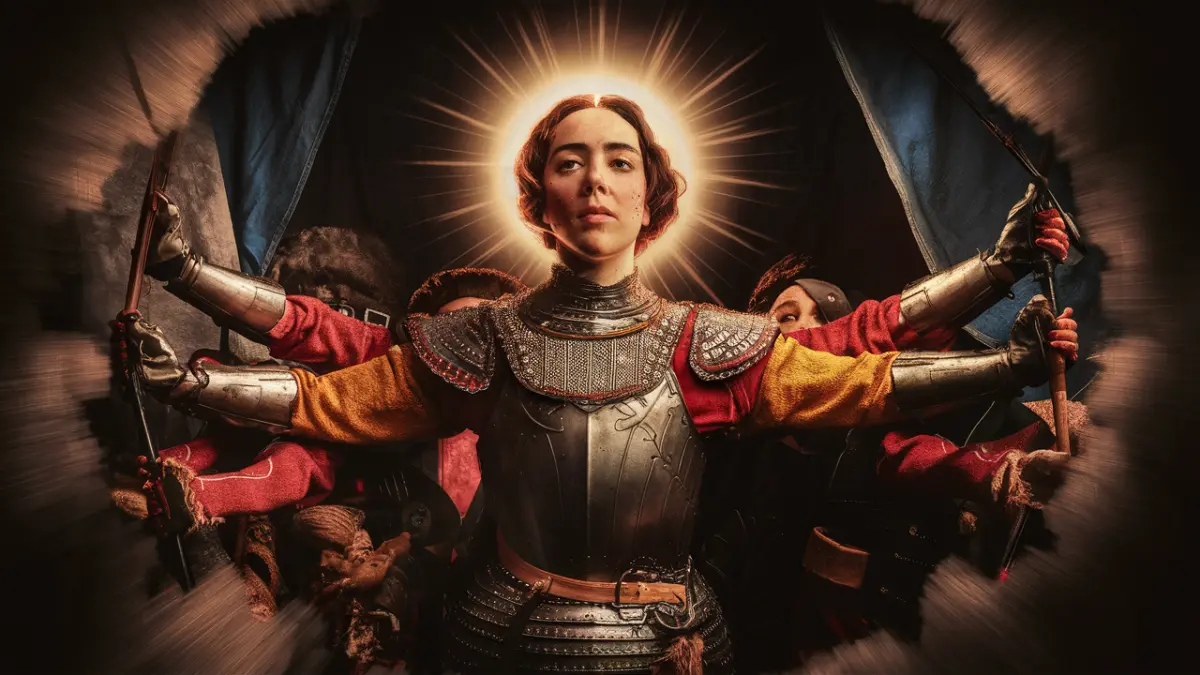10 Myths About Joan of Arc That People Still Believe Today

Joan of Arc is one of history’s most intriguing figures, wrapped in a cloak of mystery and myth. Many stories have sprung up around her life, some of which are more fantasy than fact. What are the real truths behind these legends? This article will take a closer look at ten common myths about Joan of Arc that people still believe today.
From her miraculous visions to her dramatic trial, Joan’s story has been told and retold, often with added flourishes. It’s time to separate the fascinating facts from the fiction and see just why Joan of Arc continues to captivate people centuries later.
1. Joan was a peasant girl
Joan of Arc, born in 1412 in Domrémy, France, was indeed a peasant girl. She grew up farming and looking after livestock.
Life in her village was simple, far from the grandeur of courts and castles. No fancy dresses or royal lineage here—just a hardworking family earning their keep.
Despite her humble beginnings, Joan believed she was chosen by God, leading her to rise above her peasant roots.
2. She never once wore armor
Many people think Joan of Arc never put on armor. Not true.
Joan of Arc suited up in armor for battle. She got a custom set of armor from King Charles VII.
She even had her own helmet, which she used when joining her troops. So, yes, she really did wear armor.

3. Joan's army was small
Contrary to popular belief, Joan of Arc's army wasn't some grand, massive force. Her troop sizes were often quite modest, especially at the start.
She rallied the people and convinced commanders to support her cause, but her army grew slowly. Despite the smaller numbers, their strategic brilliance and morale made them mighty on the battlefield.
In fact, it was their unwavering spirit and her leadership that turned the tide in many battles, rather than sheer size.
4. Burned for Heresy
Joan of Arc was burned at the stake for heresy in 1431. The English and their allies accused her of witchcraft and dressing like a man. She claimed God sent her to save France. They didn’t buy it.
Her trial was a mix of politics and religion. The judges pressured her to deny her visions. She refused and was found guilty.
Dressed in men’s clothes, Joan’s execution was meant to set an example. Instead, it made her a legend.

5. Never Saw Combat
Joan of Arc led armies but never swung a sword herself. She inspired troops and made strategic decisions. Folks might picture her charging with a sword, but she was more like a medieval coach.
She wore armor for battle, yet stayed out of direct fighting. Her role was rallying the troops, not dueling enemies. Her bravery came from leading, not brawling.
6. She couldn't read or write
Joan of Arc, famous for her bravery and leadership, couldn't read or write. It's true. She grew up in a small village where formal education wasn't an option.
Yet, this didn't stop her from leading armies and making history. She had incredible memory and could remember complex messages and strategies. Plus, she relied on scribes for writing.
It's a good reminder that being literate isn't the only way to achieve greatness. Joan proved it by leading an army to victory!
7. Claims of visions were fake
Some say Joan of Arc's visions were all just made up. According to skeptics, she invented her divine experiences to get attention or gain power.
Joan claimed she saw saints and heard voices from God. She insisted these visions guided her actions in the Hundred Years' War. Many believed her, and she changed history.
Critics argue she might have been influenced by religious teachings, dreams, or even mental health issues. Yet, Joan's unwavering faith and success in battle make it hard to dismiss her as a fraud.
8. Feared by the English
Joan of Arc was a major thorn in the English side. Her courage on the battlefield and her knack for inspiring her troops made the English really nervous.
They called her a witch, thinking no ordinary peasant girl could rally armies and win battles. Her presence was enough to shake even the toughest English soldiers.
Her capture was a big win for the English, but even in captivity, she remained a symbol of French resistance.
9. No trial records exist
People often think there are no records from Joan of Arc's trial.
This isn't true. There are official records. They reveal so much about the medieval legal system and Joan's life.
The trial was in 1431. It took place in Rouen, France.
These records give us a close look at her bravery and faith.
It's amazing that such detailed records still exist. They show her words and the unfairness she faced. People can read them today.
10. Died without a fight
Some people think Joan of Arc just gave up at her execution. Wrong! She was a fighter to the end. Even when they tied her to the stake, she stayed true to her beliefs. Many stories say she “surrendered” to her fate, but it’s more accurate to say she faced it with courage. Joan did not shy away from her destiny, even at the very last moment.
Joan: A Teenage Peasant To National Hero
Joan of Arc’s story is one of rising from a humble background to becoming a national symbol of France. Her journey from a modest village life to leading an army is nothing short of miraculous.
Her Humble Beginnings
Joan of Arc, born in 1412, hailed from Domrémy, a small village. Her parents were simple peasants. Despite their limited means, Joan's parents provided her with a strong religious foundation. Like many rural kids, she grew up helping in the fields and learning household chores.
Her community respected her for her piety. This normal village girl had no formal schooling or military training. Little did anyone know that she would soon change the course of history.
The Divine Calling
At 13, Joan began hearing voices that she believed were saints speaking to her. These voices instructed her to support Charles VII and reclaim France from English domination. She was guided by Saint Michael, Saint Catherine, and Saint Margaret.
She convinced Charles VII of her mission and, despite her young age and gender, was given command of an army. Joan’s conviction and the belief in her divine guidance energized the troops, leading to significant victories. Her charisma and faith transformed her into a national hero.
Misconceptions About Her Armor And Sword
Many myths surround Joan of Arc's armor and sword. People often believe fanciful stories, but the truth is quite interesting.
The Truth Behind The Armor
Joan of Arc, a legendary female warrior, supposedly had an elaborate suit of armor. Contrary to popular belief, there's no detailed depiction of her wearing it. The only contemporary illustration shows her with a sword and banner, not in full armor.
Her armor probably wasn't flashy or gold. She likely wore practical armor, similar to what many soldiers wore at the time. This wouldn't have made her stand out, but it provided necessary protection.
Some tales suggest her armor was found in a Paris antique shop, but there's no proof to back this up. Joan's armor remains a mystery, with more legend than fact surrounding it.
Mysteries Of The Sword
Joan's sword, like her armor, is shrouded in myth. People often think this sword had mystical powers. However, there’s no evidence supporting these magical attributes. Joan herself described her sword with five crosses and spoke of removing rust easily. The Church even questioned if she gave her sword supernatural powers, which she denied.
Detailed records of her trials barely mention the sword, adding to the mystery. Unlike famous swords like Excalibur, Joan's weapon didn't become legendary due to fairy tales but rather because of her incredible story. Historians are still scratching their heads over its true significance and design.
Rumors and myths make her sword seem extraordinary, but realistically, it was a tool she used during her fights. It gained fame through her actions, not enchantments.
Joan's Relationship With The French Royalty
Joan of Arc's interactions with French royalty were complicated. From her support from Charles VII to how her allegiances were often misunderstood, it's a fascinating tale.
Support From Charles VII
Joan of Arc first met Charles VII in 1429. She claimed to have received divine visions that commanded her to help Charles reclaim his kingdom. This piqued Charles's interest. He took a calculated risk by letting her lead troops. Surprisingly, they won significant battles.
Charles saw Joan as a symbol of hope. Her presence boosted morale among the troops. When they won the Siege of Orléans, it was a pivotal moment. Although skeptical at first, Charles began to believe in her. He even allowed her to stand beside him at his coronation in Reims, cementing her place in history.
Misunderstood Allegiances
While Joan had the support of Charles VII, many others were suspicious. Her divine visions were both a blessing and a curse. Some doubted her intentions. Despite her loyalty to Charles, her actions often caused political tension.
Certain nobles thought she was overstepping her bounds. They saw her influence on Charles as a threat. This led to rumors and plots against her. After her capture, Charles did little to save her, perhaps fearing backlash. This misunderstanding of her true allegiance led to her trial and execution. Even in death, her loyalty to Charles VII remains a complex part of her legend.
